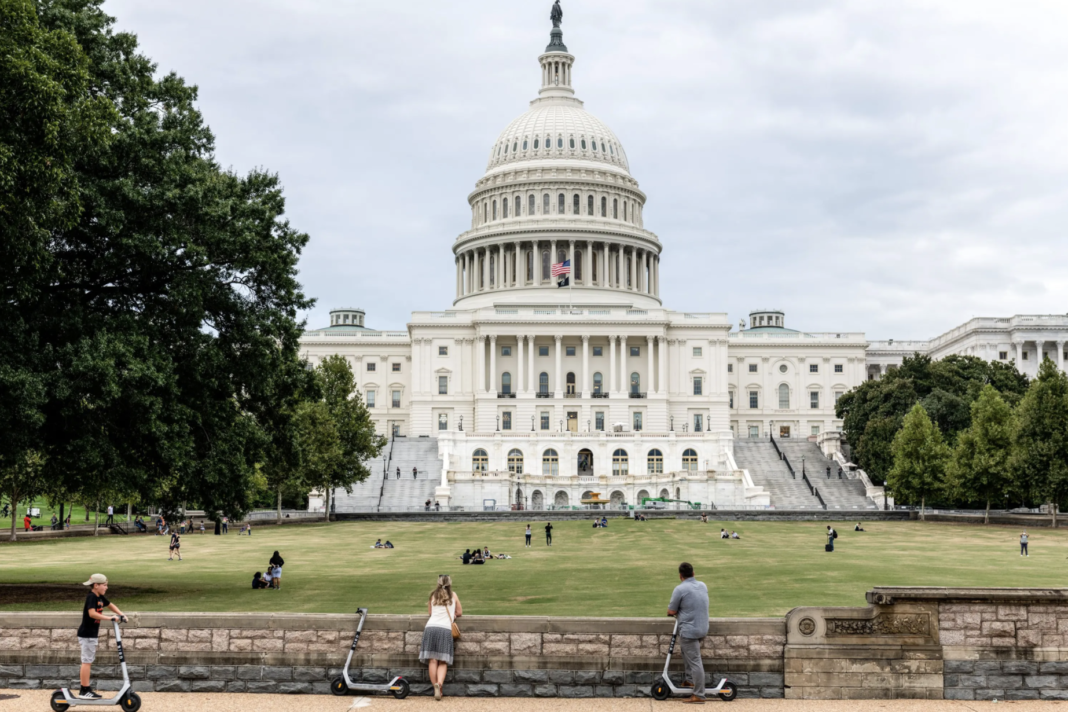Though people of color drove nearly all of Texas’ population gains in the last decade, the proposed map gives white voters control of both of the two new congressional districts the state earned.
A redraw of the state’s congressional map to include a decade of population growth could be headed to last-minute backdoor negotiations after the Texas House made a series of changes to the Senate’s proposed boundaries.
The House approved the congressional map on a 79-56 vote early Sunday, leaving in place district configurations that largely protect incumbents while denying Hispanics control of either of the two additional seats the state earned based on the 4 million new residents it gained, according to 2020 census results. Half of the new residents were Hispanic.
But the House late Saturday tweaked the Senate-approved map so that two Black Democratic members of Congress in the Houston area would not be pitted against each other. The chamber also amended the map to just barely restore the Hispanic-majority electorate of a Central Texas district stretching from Austin to San Antonio that the Senate plan had shrunk.
Early Sunday morning, the Senate rejected those changes and requested what’s known as a conference committee, made up of members of both chambers, to hash out the differences. That deal would require an additional vote by each chamber before this third special session ends Tuesday.
The congressional map bolsters Republican control in Texas by manipulating district boundaries around communities of color. Republicans are submerging diverse suburban areas into sprawling rural districts that would be controlled by white voters. Though people of color drove nearly all of Texas’ population gains in the last decade, the map gives white voters control of both of the two new congressional districts.
Republicans opted to place one of those districts — the 38th Congressional District — in the Houston area, drawing it as safe GOP territory. The other district — the new 37th Congressional District — was drawn in the Austin area to capture liberal voters and help shore up surrounding GOP districts that had increasingly presented Republicans with tougher reelection fights.
“This map is a bad map — it’s a map that does not reflect that the tremendous growth of our state is 95% attributable to Texans of color,” said state Rep. Chris Turner, the Grand Prairie Democrat who chairs the party’s caucus in the House. “It gives the two new districts that Texas received through apportionment to Anglos. That is the fundamental defect of this map.”
Throughout the evening, Democrats warned of “blatant legal defects” that undermine the electoral strength of voters of color in choosing their representatives in Washington, D.C. At times offering vague reasoning for their opposition, the House’s Republican majority repeatedly rejected their bids to rework the map and create additional districts in which voters of color could control elections.
A failed proposal to create such a district for Hispanics in western Dallas County grew particularly contentious as state Rep. Jacey Jetton, R-Richmond, spoke against the proposal, noting it would reduce the Hispanic population in a neighboring Democratic district.
In response, state Rep. Rafael Anchía, the Dallas Democrat who had offered the proposal, questioned why Republicans would object to the new district while signing off on a configuration that instead draws some of those Hispanics into a massive rural district with almost surgical precision.
Under the plan Republicans approved, the 6th Congressional District — which stretches across seven mostly white rural counties to the south of Dallas — extends a finger northward into Dallas County to capture Hispanic neighborhoods. That engineering simultaneously boosts white voters’ control of the district while stranding Hispanic voters who in the past were concentrated enough to influence election outcomes.
“You really have to try hard to deny Latinos in North Texas the ability to select that candidate of their choice, but that’s what’s baked in this plan,” Anchía said.
The congressional map was largely devised in the Senate where lead author Sen. Joan Huffman, R-Houston, has said she drew the map “race-blind” but ran it by state lawyers to ensure it stood up to legal requirements for the redistricting process.
In first presenting the map to the House, state Rep. Todd Hunter, the Corpus Christi Republican leading the House’s redistricting work, largely stuck to reading off the Senate’s map-drawing “priorities,” including “partisan considerations,” keeping communities of interest together and complying with the federal Voting Rights Act of 1965.
But he acknowledged the map, as it came over from the Senate, reduced the number of districts in which Hispanic Texans make up the majority of eligible voters.
In reconfiguring the Austin-area districts, the Senate had brought the share of Hispanic eligible voters in the 35th Congressional District down from 52.6% to 48%. House Republicans voted to give Hispanic voters a marginal majority by bringing them up to 50.5% of eligible voters in the district, which is currently represented by longtime Democratic U.S. Rep. Lloyd Doggett.
In that same amendment, Republicans also upped the percentage of Hispanic eligible voters to exactly 50% in CD-27, a district that runs from the Gulf Coast up to Central Texas. But the seat would likely remain under Republican control, giving Donald Trump a hypothetical 20.5-percentage-point margin of victory at 2020 levels of support. The district is currently represented by Republican Michael Cloud of Victoria.
Democrats voted against those changes because they also served to further boost Republican performance in neighboring CD-15, which is anchored in Hidalgo County. The Senate reconfigured that district to flip it from one that Joe Biden narrowly carried to one that Trump would’ve won by 2.6 percentage points. Under the House’s changes, Trump’s margin of victory would increase to 4.6 percentage points.
The CD-15 incumbent, U.S. Rep. Vicente Gonzalez, D-McAllen, has said he would move to run for reelection in the reconfigured CD-34, which was unexpectedly close in 2020 but was shored up as a safe Democratic seat. But it appears he will be able to stay put, thanks to a Democratic amendment passed Saturday that would draw his residence into CD-34.
Save for exceptions like CD-15, the GOP appeared to prioritize incumbent protection over aggressively running up the party’s numbers in the congressional delegation. But the map does in fact give Republicans a bigger edge, increaing from 22 to 25 the number of districts that would have voted for Trump in 2020. The state’s current delegation consists of 23 Republicans and 13 Democrats.
In light of the resistance to giving voters of color more electoral control, Democrats invoked the state’s long history of diminishing the influence of people of color in its map-making, which runs through the state’s last round of redistricting in 2011. A federal court found the Legislature intentionally discriminated against Hispanic and Black voters by diluting the strength of their votes.
Throughout this year’s redistricting fight, though, Republicans leading the House’s redraw have resisted accepting the Legislature’s past missteps. When asked Saturday what steps were taken to avoid a repeat this year, Hunter said he disagreed that the Legislature was found to be at fault in the last redistricting cycle.
He pointed to a 2018 ruling by the U.S Supreme Court that cleared the state’s current maps, with just one exception. But that ruling only dealt with the Legislature’s 2013 decision to adopt the temporary maps a court ordered for the 2012 elections amid litigation over the maps the Legislature drew in 2011, which never went into effect.
This year marks the first round of political redistricting in Texas since the Supreme Court struck down a federal safeguard meant to protect voters of color from discrimination. Until that 2013 ruling, states with a racist voting history like Texas were required to obtain federal approval before enacting changes to political maps or election laws.
In light of the loss of that protection, state Rep. Toni Rose, a Dallas Democrat who serves as vice chair of the House Redistricting Committee, attempted to attach language to the redistricting legislation that would’ve required a federal court to ensure the map was not discriminatory.
“If these are fair maps, I don’t understand what’s the trepidation of having this amendment on board if this body feels that the maps are fair,” Rose said.
Her amendment failed.
One of the few Democratic-proposed changes accepted Saturday was an alteration to congressional districts in the Houston region where incumbent U.S. Reps. Sheila Jackson Lee and Al Green were drawn into the same district.
Both lawmakers came to the Capitol to oppose the redrawing of their districts, which include large Black populations and some of Houston’s historically Black neighborhoods. Jackson Lee’s constituents also came out in full force, waiting several hours to testify against the change during the House’s public hearing on the map earlier this week. The House voted overwhelmingly to undo that pairing.
Like the new maps for the House and Senate, the congressional map is likely to draw the state into federal court. As it has moved through the Legislature, civil rights groups like the Texas NAACP warned lawmakers that new configurations were not reflective of the state’s population growth and would hamper Hispanic and Black voters from having their voices heard.
“You can’t rely on this growth, import two new congressional districts and then shut the community out,” Anchía said on Saturday. “It just doesn’t work legally. It doesn’t work mathematically. It doesn’t work morally.”
Carla Astudillo contributed to this report.
This story originally appeared in the Texas Tribune. To read this article in its original format, click here.








